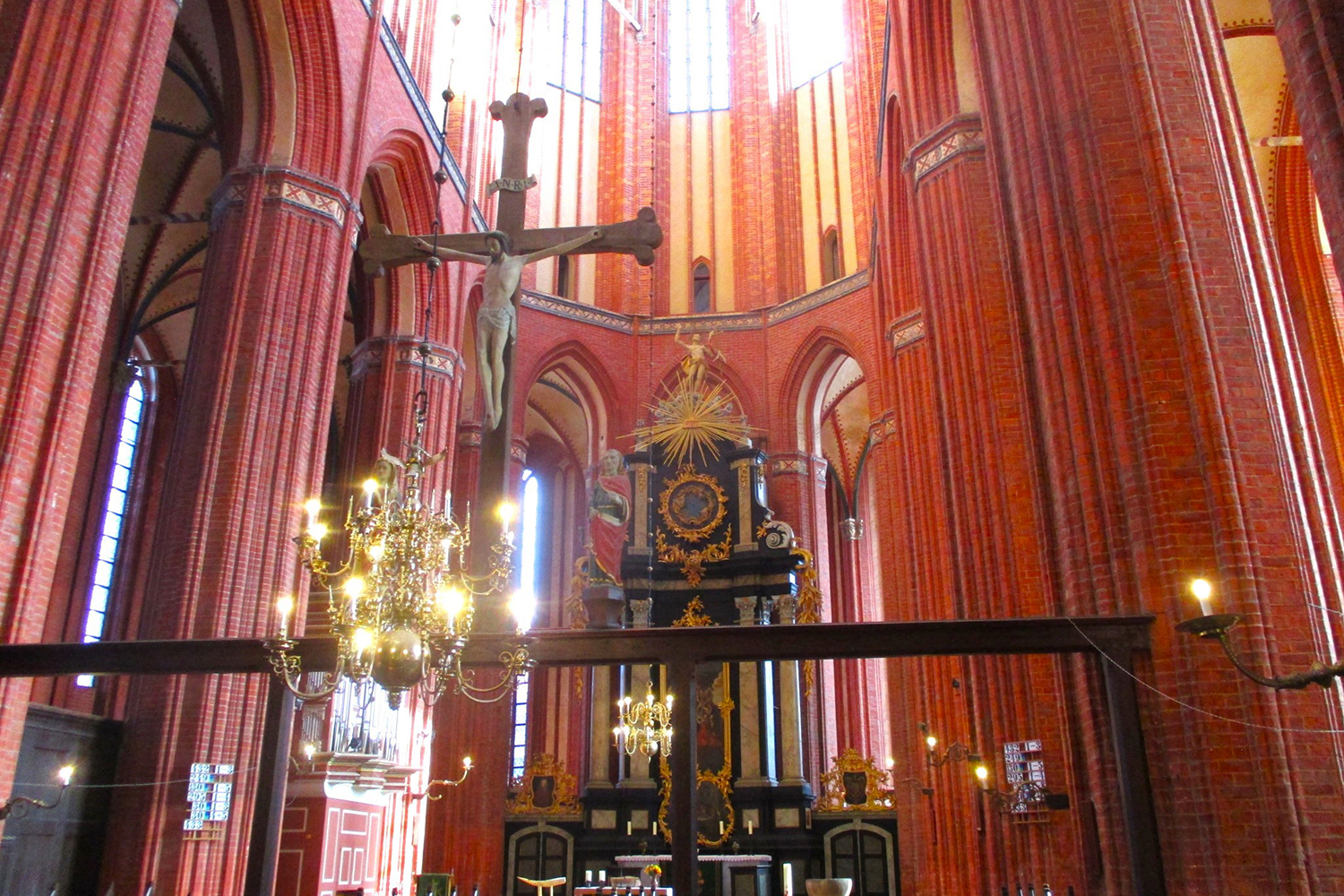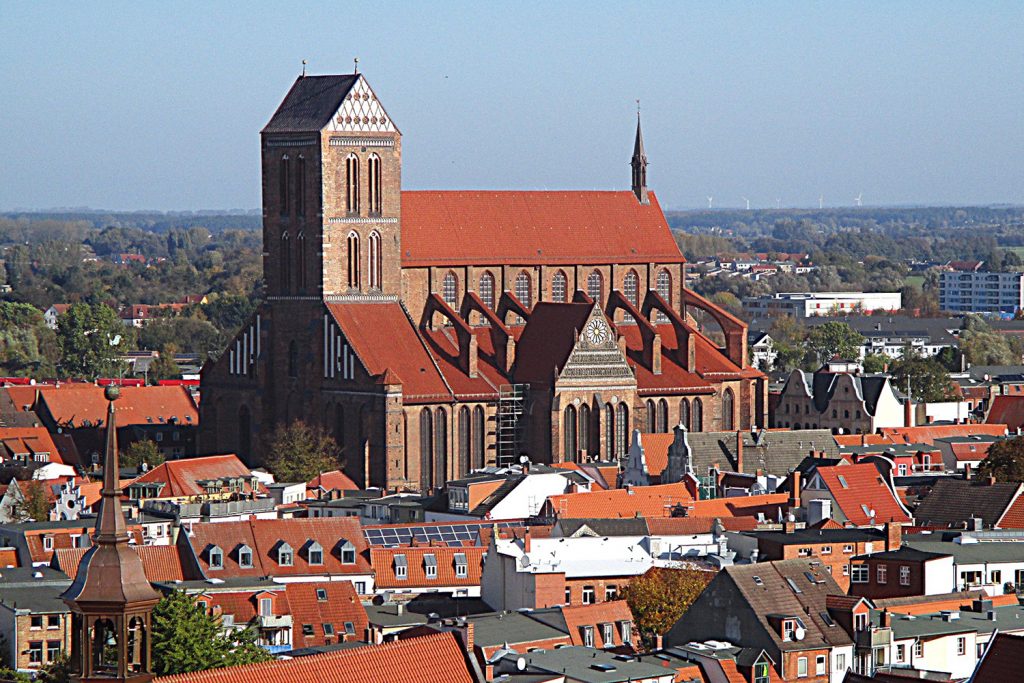Mystery Worshipper: Portola
Church:
St Nikolai, Wismar
Location: Germany
Date of visit: Sunday, 13 October 2024, 10:00am
The building
St Nikolai is a brick Gothic basilica, with the second highest nave (37 metres) in the world. Construction began in 1270 and was completed in 1459. The church contains precious works of art and side altars from the 15th and 16th centuries, and in the 18th century, the interior was redecorated in the Baroque style. St Nikolai was the only large church which remained undamaged during the heavy bombing of Wismar in the Second World War. Because worship was not resumed in the other two major churches, St. Nikolai has inherited some of their altars and works of art. The main organ, constructed by Johann Mende (1787-1850) for another church, was installed 1985. The organ used in the choir worship area was installed 2010. Under the main organ is a ‘winter church’, a heated room with tables and chairs, which is used for services from January to Easter, as well as for congregational activities. In a side aisle there is a kitchen, and a room for children’s services.
The church
Appropriate to a port city which was part of the Hanseatic League, the church is dedicated to St Nicholas, the patron saint of sailors, fishermen and merchants. The Reformation came to this church 1523-24. After the Second World War, Wismar belonged to the German Democratic Republic. In 1989, the ‘Prayer for Peace’ protest movement, which contributed to the peaceful revolution that brought down the Iron Curtain, had a platform in this church. At the moment there are events commemorating the 35th anniversary of this historical turning point. St Nikolai is linked to three other churches in Wismar, forming a community which shares a newsletter and common activities. Among the happenings in St Nikolai are a ‘young congregation’, a club for parents and children, a teenie church, a Prayer for Peace, and movie evenings. Twice a week, meals are offered for needy people. The Protestant Music School and the Kantorei Wismar (a choir) also use the church for rehearsals and concerts. In the Middle Ages 40 clerics served in this church; today there is one pastor.
The neighborhood
The Hanseatic City of Wismar was founded in 1226. It is a port city on the Bay of Wismar on the Baltic Sea, which joined the Hanseatic League in 1259. In 1632, it was captured and held by Sweden until 1803. The skyline of the city is dominated by three monumental brick churches: St Nikolai, St Marien (only the tower survives) and St Georg. In 2004, Wismar became a UNESCO World Heritage Site because of its picturesque brick Gothic structures and rows of vintage gabled patrician houses. For movie fans, it might be worth mentioning that the first adaptation of Bram Stoker’s Dracula was filmed in Wismar in 1922. It was titled Nosferatu: A Symphony of Horror. It is regarded as a legendary Expressionist silent movie classic.
The cast
A retired woman pastor presided and preached; two lay people served as lectors.
What was the name of the service?
Gottesdienst (Divine Service).How full was the building?
There were an estimated 50 people, who almost filled the five rows of pews in the choir, where worship is celebrated; some people sat in the nave, outside the choir. It looked like the church has a capacity of about 300.
Did anyone welcome you personally?
No personal welcome. Worshippers helped themselves to hymn books, which were laid out on a table.
Was your pew comfortable?
The antique pew was comfortable because I had ample leg room and cushions were provided.
How would you describe the pre-service atmosphere?
There was a quiet murmer of conversation.
What were the exact opening words of the service?
‘A hearty welcome to this service on the 20th Sunday after Trinity.’ During the greeting, the pastor mentioned that today was ‘Men Sunday’. To commemorate this day, a hymn was selected which is traditionally popular with men’s choirs. (Post-rehearsal beer drinking is allegedly also a tradition of men’s choirs.)
What books did the congregation use during the service?
Two books: the Hymn book of the Evangelisch-Lutherische Kirche der Landeskirche Mecklinburg, and Heaven, Earth, Air and Sea, a Supplement to the Protestant Hymnbook of the Northern Church. The Bible readings were taken from the Basis Bibel and Hoffnung für alle – Hope for Everyone – simplified translations which attempt to make Bible texts more readily accessible for people without a biblical background.
What musical instruments were played?
The choir organ, installed in 2010, was built by Johannes Soldan, who used stops of the predecessor organ dating from 1862.
Did anything distract you?
The sanctuary had a clammy chilliness. My hymn book looked like it had suffered from moisture, as the pages stuck together and were wrinkled, which made me aware that a harbour of the Baltic Sea was just a five minute walk away.
Was the worship stiff-upper-lip, happy clappy, or what?
The service was a sober Lutheran liturgy without holy communion. The words of the liturgy were inserted into the hymn books, but the congregation was expected to know the melodies from memory. A lay woman read an Old Testament reading and the Gospel; the congregation stood for both readings. After the first reading, two children were brought to the Easter candle to light personal candles, and were then conducted to the back of the church for a children’s service. Instead of the traditional Apostles’ Creed, a modern creed was read by a lector. This creed had some expressive formulations, but the crucifixion and resurrection of Christ were not mentioned. The pastor wore a colourful green stole. Stoles are allowed but are seldom used by Protestant pastors in Germany, who customarily wear only a black cassock. The organist was the star of the service with his lively accompaniments of the hymns. His sparkling postlude did produce a happy-clappy reaction in one adult and one child.

Exactly how long was the sermon?
19 minutes.
On a scale of 1-10, how good was the preacher?
7 — She spoke with clarity, down-to-earth authenticity, and without pretension.
In a nutshell, what was the sermon about?
In a letter to the Corinthians, Paul tells the congregation: you are a letter of Christ, written by the Holy Spirit. Christians are illustrations of Christian faith, they convey messages which people can ‘read’. We should allow room for the love of Christ in our hearts, so that this love radiates the message: you are loved. We are the hands, feet and lips of Christ, expressing his care for all people. We do not need a special authorisation or outward approval to be his messengers. What we learn through the normal course of Christian living is adequate for this calling. The Holy Spirit, working in our hearts, gives us the assurance we need.
Which part of the service was like being in heaven?
This sanctuary has an other-worldly atmosphere. When the sun shines in through the high windows, as it did on this Sunday, the orange-red bricks of these monumental Baltic churches seem to have an inner glow which radiates a comforting warmth. The extraordinary loftiness of the ceiling conveys heavenly transcendence. It is mind-boggling that St Nikolai consists of 3 million bricks.
And which part was like being in... er... the other place?
The congregational singing seemed to be non-existent. Apart from myself and Mrs Portola, I could not hear any singing. In German Protestant churches, the congregation remains seated during the hymns, which contributes to thin singing.
What happened when you hung around after the service looking lost?
During the after-service coffee I stood around looking lost. After a while, I was approached by a couple who were also visitors, and we got into a long and deep conversation about various aspects of church life.
How would you describe the after-service coffee?
The coffee was excellent, served in porcelain cups with saucers. Tea and tasty sandwiches were also offered. A large portion of the congregation participated in the after-service fellowship. I did not mind being left alone as a visitor, because it was enjoyable to observe the congregation engaged in animated conversation and to take in the wonderful architecture.
How would you feel about making another visit (where 10 = ecstatic, 0 = terminal)?
10 — One can get addicted to ancient red-brick Gothic churches, which are prevalent in this northern part of Germany.
Did the service make you feel glad to be a Christian?
Yes, indeed. The Spirit of Christ is to be found everywhere.
What one thing will you remember about all this in seven days' time ?
The postlude was a skilful improvisation based on the Israeli melody of the final hymn of the service: ‘Hevenu Schalom Alejchen’. The liveliness of the music was electrifying; the joyfulness was infectious. A child in the front row stood up and danced. The organist himself seemed to be dancing in a sitting position. Seldom have I experienced such pulsating energy in a piece of organ music. I could have listened to this organ music seemingly forever.
